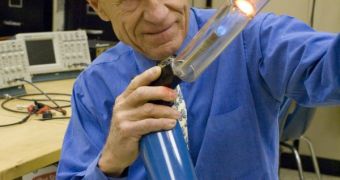That's exactly what a team of scientists observed in an experiment and then transformed into a practical device. The gadget can turn heat into sound and then into electricity and is very promising as an effective method of transforming waste heat into electricity, harnessing solar energy and cooling computers and radars.
Orest Symko is an University of Utah physics professor who leads the team, and he said they are planning to test the device within a year to produce large scale electricity from waste heat at a military radar facility and at the university's hot-water-generating plant.
"We are converting waste heat to electricity in an efficient, simple way by using sound," says Symko. "It is a new source of renewable energy from waste heat." Of course, the first to benefit from this technological achievement will be the US Army, who funded the research and is interested in "taking care of waste heat from radar, and also producing a portable source of electrical energy which you can use in the battlefield to run electronics"
How exactly does it work? Well, they use the piezoelectric effect, the ability of crystals and certain ceramic materials to generate a voltage in response to applied mechanical pressure. There are two steps in the newly developed process.
First, a new heat engine, technically called "thermoacoustic prime movers," converts heat into sound. The team used cylinder-shaped "resonators" that fit the palm of your hand, that contain a "stack" of material with a large surface area - such as metal or plastic plates, or fibers made of glass, cotton or steel wool - placed between a cold heat exchanger and a hot heat exchanger. One only needs to apply heat, that builds to a threshold and causes the air to move and produce sound at a single frequency, similar to air blown into a flute.
"You have heat, which is so disorderly and chaotic, and all of a sudden you have sound coming out at one frequency," Symko said. "It's an extremely small thermoacoustic device - one of the smallest built - and it opens the way for producing them in an array," he continued.
The second step is represented by the sound waves that squeeze the piezoelectric device, producing an electrical voltage. The main advantage of these applications is the fact that they don't require moving parts to convert heat to sound and then to electricity, thus requiring little maintenance and last a long time and almost no loss in efficiency over time.

 14 DAY TRIAL //
14 DAY TRIAL //